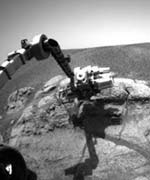
Image credit: NASA/JPL
On sol 31, which ended at 3:36 a.m. Wednesday, February 25, Opportunity awoke to “Rock Around the Clock” by Bill Haley and his Comets. At 1:00 a.m. Local Solar Time, Opportunity sent data to Earth via the Mars Global Surveyor orbiter and then sent another whopping 145.6 megabits of data at 3:30 a.m. Local Solar Time via the Mars Odyssey orbiter.
During the morning hours, Opportunity collected data with the alpha particle X-ray spectrometer for five hours and took measurements with its miniature thermal emission spectrometer from inside its newly formed hole that was created on sol 30 by the rock abrasion tool. Later, Opportunity retracted and closed the door of the alpha particle X-ray spectrometer and swapped the Moessbauer spectrometer into the hole made by the abrasion tool for a leisurely 24-hour observation.
Opportunity also updated its “attitude knowledge,” which fine-tunes the rover’s information about its exact location and position on Mars. Updating the attitude knowledge allows the rover to more accurately point the high gain antenna toward Earth, which increases the communications capabilities. The attitude adjustment also enables scientists and engineers to point instruments onboard Opportunity more precisely at targets of interest, such as particular rocks and patches of soil. To adjust the attitude knowledge, engineers have the rover turn the panoramic camera to the Sun and watch the Sun travel across the sky for 15 minutes. The rover is then smart enough to take the Sun movement data collected from the panoramic camera to calculate its own location in the universe?..on Mars. The rover gathers attitude knowledge errors over time as it drives and uses the robotic arm extensively, but it only needs an attitude adjustment about once a week or after driving long distances.
Around 12:15 pm Local Solar Time, Opportunity went to sleep to recharge its batteries from its strenuous rock abrasion tool activities on sol 30, but reawakened briefly at 4 p.m. Local Solar Time and again in the evening to send data to Earth via additional overflights by the Mars Global Surveyor and Odyssey orbiters.
The plan for sol 32, which ends at 4:15 a.m. Thursday, February 26, is to take another unique set of Moessbauer measurements to look at the rover-created hole in a different spectrum. The goal is to then crawl slightly forward on sol 33 to position Opportunity to use the rock abrasion tool on the upper target of the El Capitan/McKittrick area.
Original Source: NASA/JPL News Release
